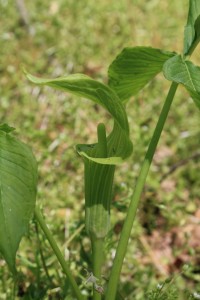Jack-in-the-Pulpit – April 2017 Wildflower of the Month
 Jack-in-the-pulpit (Arisaema triphyllum) is an easy to grow native wildflower that has unusual foliage and flower. The striped green and purple canopy (spathe) curves gracefully over a club-shaped spadix (the “Jack” or preacher in his canopied pulpit). The lower portion of the spadix carries tiny flowers of one or both sexes, where heat and odor are produced, attracting pollinating flies.
Jack-in-the-pulpit (Arisaema triphyllum) is an easy to grow native wildflower that has unusual foliage and flower. The striped green and purple canopy (spathe) curves gracefully over a club-shaped spadix (the “Jack” or preacher in his canopied pulpit). The lower portion of the spadix carries tiny flowers of one or both sexes, where heat and odor are produced, attracting pollinating flies.
A single 3-parted leaf on a long stalk then expands and overtops the spathe. Appearing along with the flowers, the leaves are divided into 3 parts, the two lower leaflets more or less horizontal to the third leaflet. Jack-in- the-Pulpit leaves could be confused with those of trillium, but the 3 leaflets of trillium are all equidistant from each other.
Fruits are smooth, shiny green berries clustered at the base of the thickened spadix; they ripen in late summer when the spathe and leaf wither, revealing the cluster of bright red berries borne on a stalk 1-2 feet high, replacing the leaf and flower.
Jack-in- the-Pulpit is an excellent choice for a shade or woodland wildflower garden where it will thrive in rich soil and partial to full shade. It is very easy to cultivate and requires little care, and grows under a variety of conditions. It partners well with columbine (Aquilegia canadensis) and foamflower (Tiarella cordifolia).
Native in all counties of Virginia, this woodland plant is found in every state east of the Mississippi, and extends through central U.S. to the borders of Colorado and Utah and into Canada.
While birds and mammals eat the berries of this plant, all parts produce intensely irritating calcium oxalate crystals. American Indians knew that cooking and drying eliminated the bitter taste; roots were used as a vegetable, ground for bread doughs, and used for a variety of medicinal purposes.
Arisaema refers to the plant’s resemblance to other members of the Arum family, the Araceae – Skunk Cabbage (Symplocarpus foetidus), Arrow-arum (Peltandra virginica), and Golden Club (Orontium aquaticum) are native to Virginia. Other members of this family from the tropics are grown as familiar house plants. Peace Lily (Spathiphyllum), Philodendron, and Dieffenbachia are sold locally in garden centers and nurseries. Another relative Caladium, also known as Elephant Ears, is grown for its colorful foliage and is often planted in woodland gardens.
By Helen Hamilton, president of the John Clayton Chapter, VNPS
Photo: Jack-in- the-Pulpit (Arisaema triphyllum) taken by Phillip Merritt
